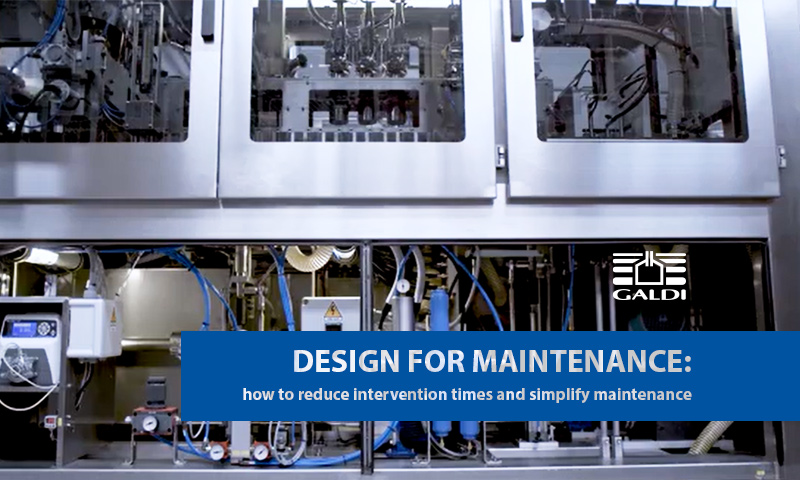Design for Maintenance applied to Filling Machines
In machines designed with this approach, the focus lies on maintenance requirements, to reduce servicing times and simplify operations, enhancing packaging machine efficiency

Ultimately, the purpose of Design for Maintenance is to simplify the work of maintenance technicians, making filling machine repair more straightforward and reducing downtime.
Over the last few years - and especially in the design of our RG270 model - we have made considerable progress in this direction, as ergonomics requirements and a structured scientific analysis have guided our packaging machine design.
LISTEN TO THE ARTICLE
TECHNICAL ANALYSIS CRITERIA FOR DESIGN FOR MAINTENANCE
We reviewed both regular and corrective maintenance work carried out on our packaging machines, paying special attention to two factors: the frequency of operations and their level of difficulty.
Our designers first assessed positioning and design choices for components and work areas, taking into account the tasks listed in the Planned Maintenance Plan (PMP).
They sifted through all scheduled replacements, for parts with 250 and up to 4,000 hours of operation, according to the following criteria:
- accessibility
- safety
- comfort
- execution time
In our risk assessment, we also addressed the needs of large manufacturing companies, where maintenance technicians work on several machines every day, complying with the strictest safety standards.
And, of course, we analysed corrective maintenance operations as well, to ensure an even more timely intervention, emphasizing the need for troubleshooting packaging equipment.
DESIGN FOR MAINTENANCE AND WORK AREAS
When a machine is designed according to Design for Maintenance principles, reducing servicing times is one of the main objectives. This directly impacts packaging machine efficiency.
This is key for both routine work and to cut MTTR ("Mean Time To Repair") in the case of corrective maintenance, so as to make machines fully functional again in the shortest possible time.
To reach this goal, recurrent and complex operations are carried out - wherever possible - at ground level or at operator's height, facilitating filling machine maintenance.
In new filler models, there is an increasing trend toward grouping components, as well as relevant operations, in specific and easily accessible areas. This practical application of packaging system design principles significantly eases maintenance efforts.
An example of design for maintenance: all devices that require topping up tend to be in the same location, just as all air filter and prefilter sets are placed at the end of the filler.
The lower sections of the fillers are designed to allow for easy access to mechanical parts, e.g. lifter or main shaft adapter and respective motor.
By removing unnecessary components that could hinder operations, designers "shape" the frame and internal areas to overcome tight spaces and avoid that maintenance technicians work in uncomfortable or harmful positions.
As for work at height, Galdi's new generation machines are designed to not require, wherever possible, the use of platforms - due to high cost, bulky size and increased risks.
Whereas for components that seldom need maintenance, design is geared toward using a normal ladder, taking the following precautions:
● replacing components shall not require the use of heavy objects
● parts must be placed where they are easiest to reach
● maintenance technicians shall be able to conduct several operations without changing position or leaning too far out.
HMI DEVELOPMENTS AND PREDICTIVE MAINTENANCE
Research and development efforts to improve the work of maintenance technicians address both hardware, based on Design for Maintenance principles, and software components.
Since the conception of our RG270 model, the HMI ("Human Machine Interface") has been totally transformed to ensure utmost simplicity, a step forward in packaging machine design.
We created specific sections for operators and maintenance technicians, removing unnecessary information.
A clearly visible alert list is displayed on the "Maintenance" page, flagging areas with potential problems, like insufficient product, machine clogging or issues in the carton area.
A further step forward is MaSH advanced monitoring system. The platform's features include the analysis and detection of recurrent alerts, improving troubleshooting and enabling failure prediction.
Along with the work done on the basis of Design for Maintenance, we also carried out an analysis of the ergonomic qualities of filling machines, focusing on the daily work of operators.
EXPLORE INNOVATION IN DESIGN FOR MAINTENANCE
Want to ensure your packaging operations are as efficient and smooth as possible? Discover how our filling machine models, designed with maintenance in mind, can transform your production process.
Contact us for a personalized consultation and begin maximizing your packaging equipment's potential!

